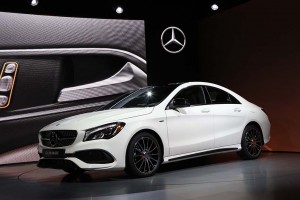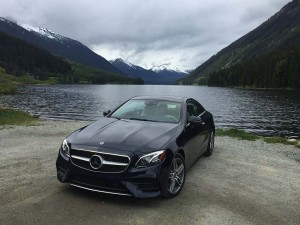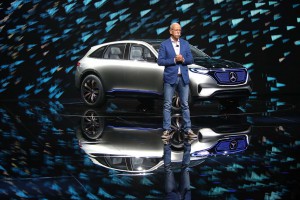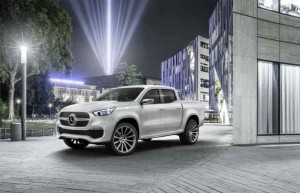A handful of reporters got the chance to check out the newest addition to the Mercedes-Benz line-up this week, slaloming through the winding mountain roads north of Vancouver, British Columbia in the 2018 E-400 Coupe. But even as the media drive was underway, Mercedes confirmed yet another version of the midsize mainstay was on its way, the completely redesigned E-Class Cabriolet.
By the time both the E-Class coupe and convertible reach showrooms in the coming months, Mercedes will have a whopping 83 different products on sale in the U.S., and there are a number of additional products available for buyers abroad that don’t make it to the States, such as the little A-Class line and the big R-Class people-mover.
But Mercedes isn’t about to relax. If anything, it is ramping up its product assault with an array of offerings now in various stages of development, including its first pickup and an assortment of battery-electric vehicles, or BEVs, that will be sold through a new sub-brand, Mercedes-EQ.
“We’re constantly looking at what niches there are out there,” in a bid to fill in potentially profitable “white spaces,” Bernie Glaser, Mercedes-Benz USA’s product manager, told TheDetroitBureau.com during a lunch break out in the wilds of British Columbia.
That’s a markedly different strategy from the conservative approach to product Mercedes and parent Daimler AG took in the past. For years, it limited its line-up to a handful of key models, the predecessors of today’s E-, S- and SL-Class lines. In the early 1980s, members of the company’s board and senior managers came almost to blows debating whether to add the little 190 model – known by the nickname, “Baby Benz,” it was the progenitor of today’s C-Class.
While there are still some heated debates over what new models to market, Mercedes now seems almost desperate not to miss any potential white space. The current global line-up is an alphabet soup running from the little A-Class to the massive G-Class, or Gelandewagen SUV. In-between are products such as the B-Class, the CLA and GLA, the SLC and GLE, the R-Class an all manner of sedans, coupes, convertibles, wagons, crossover utes and traditional utility vehicles.
Then there are all the variants – the asterisk after that 83 model number. With rare exception, most models also are offered with different gas and, occasionally, diesel options. There are a growing number of conventional hybrids and, by year-end, Mercedes will have 10 plug-in hybrid-electric vehicles, or PHEVs, on sale worldwide, seven of them here.
“The product offensive will continue,” said Glaser, noting Mercedes is pushing into even greener space, with a variety of BEV variants. And, at the Paris Motor Show last November, Daimler CEO Dieter Zetsche announced the creation of the new Mercedes-EQ sub-brand – which will target the likes of BMW’s own, green “i” brand-within-a-brand.”
The first EQ model will hit showrooms within two to three years, noted Glaser, with a full 10 due by 2022. “We’ll see how many will come to the U.S.,” he said.
(Daimler investing billions in new battery plants. Click Here for the story.)
Separately, Mercedes is developing new hydrogen fuel-cell technology and at least one new FCV will soon find its way to the States – though like the hydrogen cars now offered by Hyundai, Honda and Toyota, it will be limited to regions of California where public refueling stations are available.
While Mercedes has launched a line-up of new E-Class models – and with a major update for its S-Class flagship to follow – its most aggressive push has been into the utility vehicle space: from the entry GLA to an updated G-Wagen, as well as some curious new body styles, including coupe-like utes.
This should come as no surprise considering light trucks, in general now account for nearly two-thirds of U.S. new vehicle sales – and demand is growing in key markets like Europe and China, as well.
Meanwhile, Mercedes is getting ready to debut its first-ever pickup, the X-Class. There currently are no plans to bring it to the American market, Glaser cautioned, as it is a midsize truck and most American pickup buyers prefer full-size models. But that could change. But he told TheDetroitBureau.com that could change.
(Might Mercedes enter U.S. pickup market, after all? Click Here for the story.)
Indeed, Mercedes is looking to see if the U.S. would be receptive to even more products not currently shipped across the Atlantic.

The latest version of the Mercedes-Benz CLA. The small car has attracted many 1st-time luxury buyers.
“Our compact car family will grow from five to eight members in the near future,” said Britta Seeger, the board member running global marketing and sales, during an appearance at the North American International Auto Show in Detroit last January.
She isn’t saying what’s yet coming, though a wagon variant of the current CLA is considered a strong prospect, perhaps even the A- or B-Class models currently available in Europe and other foreign markets.
Small cars and crossovers are of particular importance to Mercedes in the States, said Dietmar Exler, CEO of Mercedes-Benz USA, in a recent interview. While a vehicle like the little CLA might not deliver the profit margins of an E- or S-Class, it serves as a “gateway” to the brand. A full 70% of CLA and GLA buyers are new to Mercedes, the company revealed.
“Our brand strategy is working,” Exler said. “Get them into the brand early and keep them for life.” And by filling in as many niches as possible, Mercedes is betting there won’t be any reason to look elsewhere.
(Daimler calling it quits on U.S. diesels – at least for now. Click Here to learn why.)




he All-New KONA is not just another car among Hyundai Motor’s established SUV range – it is an important milestone of our journey to become Asian automotive brand number one in Europe by 2021. With its true SUV genes, a progressive design and premium features, KONA reflects the lifestyle of modern customers, enhancing the brand’s appeal and attracting new customers.